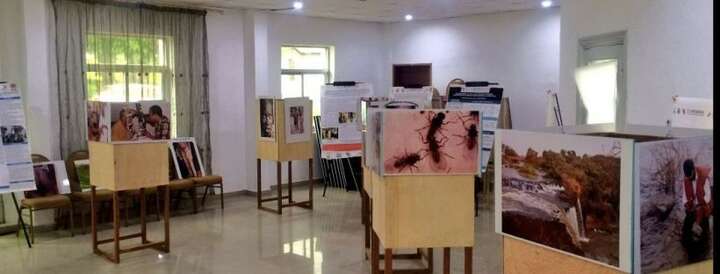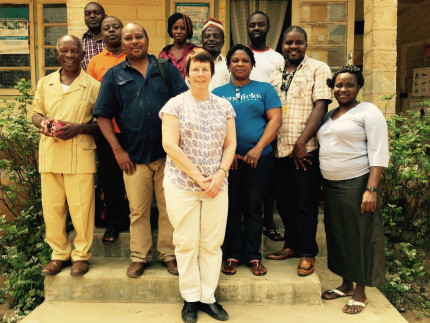
By Louise Hamill, Michele Murdoch, Mathias Esum, Jerome Fru, Samuel Teghen, Ernestine Wasso, Anicetus Suireng, Peter Enyong, Mark Taylor, Joseph Turner, Samuel Wanji
The COUNTDOWN team in Buea, Cameroon, are working hard to ensure that the assessment of skin disease caused by onchocerciasis is firmly embedded within the alternative onchocerciasis control strategies they are developing. The work, led by Professor Samuel Wanji, Dr Joe Turner and Professor Mark Taylor, aims to implement these alternative strategies for the control and elimination of river blindness (onchocerciasis) in South West Cameroon. Onchocerciasis control in South West Cameroon has been sub-optimal using conventional approaches (Wanji et al., 2015), and so new, alternative strategies are urgently needed.
Onchocerciasis is a parasitic disease, caused by worms which are transmitted by the bite of infected blackflies. Untreated, onchocerciasis leads to progressive visual impairment and eventually irreversible blindness, as well as severe itching and a range of serious skin complaints, collectively known as onchodermatitis. Efforts to control this debilitating disease have used several different approaches over the past five decades.
Previous Approaches to Onchocerciasis Control
Early onchocerciasis research concentrated on blindness, and the first large-scale control programme, the Onchocerciasis Control Programme (OCP, 1974 -2002) successfully targeted the blackfly vectors in 11 West African countries with known high rates of onchocercal blindness. However this meant that, compared to blindness, there was comparatively less data available about the incidence, severity and geographic distribution of onchodermatitis. In an attempt to address this, a study was conducted across seven different rainforest sites in five African countries, all with known low rates of onchocercal blindness. The study revealed that 28% of the population aged 5 years and above had one or more forms of onchodermatitis (Murdoch et al. 2002). This work was pivotal in the decision to establish onchocerciasis control programmes in similar communities; those with a significant burden of onchodermatitis but which had previously received low attention because of low prevalence of onchocercal blindness. The African Programme for Onchocerciasis Control (APOC) was launched in 1995, and used community-directed treatment with ivermectin in 16 countries with predominantly onchocercal skin disease. Updated estimates of the health impact of APOC show that, because of the very large number of people with onchodermatitis, skin disease was, and is, more important in contributing to the overall burden of onchocerciasis than eye disease (Coffeng et al 2014). Therefore, skin disease must be central in any approach to the control of onchocerciasis going forward.
Alternative Approaches to Onchocerciasis Control in Cameroon
The main alternative control strategy that will be implemented in South West Cameroon is test and treat with doxycycline. A smaller sub-study will look at the effect of combining doxycycline with localised vector suppression. Previous work has shown doxycycline is highly effective against onchocerciasis (Turner et al., 2010). To monitor the effectiveness of these approaches, parasitological, dermatological, health economic and social science data will be gathered. Due to the lack of data around onchodermatitis generally, and particularly data on the response of onchodermatitis to doxycycline, the team identified collection of additional data on the presence of onchodermatitis as a priority.
Strengthening Onchodermatitis Detection Capacity
With this in mind, COUNTDOWN arranged a training visit from consultant dermatologist and leading expert on onchocercal skin disease; Dr Michele Murdoch. Professor Wanji and Dr Murdoch led a week long intensive programme of classroom teaching and clinical training for nurses from endemic areas, to enable them to better recognise signs of onchodermatitis.

Dr Murdoch and some of the team who participated in the week-long training workshop
During the taught component of the workshop, the team learnt about the morphology and terminology of skin lesions, the clinical classification of onchodermatitis, and other common skin complaints. The collection of data on itching was explained and practiced through role play. In addition, there was opportunity for the team to practice form-filling for clinical signs using clinical slides of cases.
Although the severity of symptoms varies from person to person, onchodermatitis is classified into five main categories. Dr Murdoch taught the team how to recognize the characteristics of these five categories. Briefly, they are:
- Acute papular onchodermatitis: itchy papules (small bumps) are present on the skin and some swelling, is also possible. These itchy papules can cover large areas of the body.
- Chronic Papular Onchodermatitis: itchy papules which are larger than acute papular onchodermatitis, often around the waist and hips. Hyperpigmentation, whereby the skin takes on a much darker colour, may also occur.
- Lichenified Onchodermatitis: hyperpigmented skin plaques, accompanied by intense itching
- Atrophy: similar to premature aging of the skin, resulting in loss of elasticity with excessive wrinkling and dryness.
- Depigmentation: also known as leopard skin, is when pigment (colour) is lost from entire patches of skin, with spots of normal colour around hair follicles.
Read the full description of the classification of skin disease here: (Murdoch et al., 1993).
After the taught component of the workshop concluded, the team undertook three days of practical clinical training. Consenting volunteers from communities where onchocerciasis is known to exist underwent preliminary screening for skin complaints prior to the week’s training commencing. Individuals with skin complaints were then asked for further consent to volunteer in the training. Dr Murdoch conducted examinations on these individuals, and clinical signs were demonstrated and discussed with the three nurses in a teaching setting. The nurses also conducted observed skin examinations themselves and examination techniques and observations were discussed and reviewed. The ability of the nurses to accurately detect onchodermatitis compared favourably with that of Dr Murdoch by the end of the week. When the implementation begins, these nurses will be part of the field team who travel to endemic areas and survey communities for onchocerciasis infection. The increased knowledge and capability they gained will have a lasting impact on their capacity to correctly diagnose onchodermatitis in the future.
The Bigger Picture: Research and Policy on Skin NTDs
In the past, the onchocerciasis research agenda was dominated by efforts to eliminate blindness; reprioritisation of onchodermatitis within a framework for addressing onchocerciasis morbidity in general would help redress this balance. This could be done in conjunction with other skin NTDs, such as the integrated approach to managing skin NTDS proposed by Mitja et al., 2017. As they outlined, initial assessment of individual endemic skin diseases is a crucial first step towards implementing an integrated management strategy for skin NTDS. The work of COUNTDOWN in South West Cameroon can directly feed into this initial assessment. Furthermore, as a visible, outward sign of disease, skin symptoms, associated ill health and stigma, and the impact they have on general well-being, may be more important to the patient than, say, their parasitological status. Assessment of skin symptom severity over time or in response to treatment allows better assessment of the added impact any such treatment may be having, and is less invasive than standard parasitological measurements. This should be of paramount importance when formulating or revising control strategies at the national and international level.
This work is not only important for individuals who are affected by onchodermatitis, but more broadly to raise awareness of NTDs which cause skin disease, and to provide up to date evidence on their control. Evidenced based policy and planning is becoming increasing important in all areas of health research. Given the number of NTDs recognised by the WHO which can give rise to acute or chronic skin presentations (table 1), the assessment of skin disease in sub-Saharan Africa should be afforded higher priority on research agendas, particularly due to the lack of programmatic data surrounding their distribution, severity and management.
| NTD | Associated skin pathology |
| Onchocerciasis | Severe itching, nodules, onchocerciasis related dermatitis (onchodermatitis); acute or chronic papular dermatitis, lichenified onchodermatitis, “leopard skin”/depigmentation, skin atrophy, hanging groin |
| Lymphatic filariasis | Lymphoedema, elephantiasis, hydrocele, secondary bacterial infections |
| Cutaneous leishmaniasis | Multiple skin ulcers, papules, nodules, plaques, scarring |
| Leprosy | Skin patches, nodules, thickened nerves, damaged skin, permanent damage and disfigurement of eyes, nose, limbs, fingers |
| Buruli ulcer | Skin ulcer |
| Yaws | Ulceration, damage to skin, bone and cartilage |
| Mycetoma | Subcutaneous mass with sinuses and discharge, destruction, deformity and loss of function in infected areas |
Table 1: summarised from Mitja et al., 2017
Evidence on onchodermatitis is scarce, but not completely absent; Ozoh et al. performed two cross-sectional surveys of onchocercal skin disease at baseline and after 5 or 6 years of annual ivermectin treatment and found profound reductions in itching and all forms of onchodermatitis (Ozoh et al. 2011). An earlier study found that annual ivermectin treatment reduced skin symptom severity and prevalence, however there was no additional benefit when 3- or 6-monthly ivermectin treatment regimens were compared with annual treatment (Brieger et al. 1998). Re-analysis of pre-control data from Nigeria confirmed significant levels of itching and onchodermatitis in an area which was already known to have high rates of onchocercal blindness (Murdoch et al 2017), and demonstrated a strong correlation between parasitological indicators and risk of onchodermatitis. The burden of onchodermatitis uncovered by these studies shows why gathering evidence on the prevalence and severity of skin symptoms is so important. Otherwise, assessment of skin disease caused by onchocerciasis has been relatively neglected by control programmes. Data on skin disease before, during or after the implementation of mass drug administration programmes is not routinely reported, so this represents a real gap in our knowledge. The COUNTDOWN work in Cameroon will lead the way in bridging this gap, generating evidence to enable future research and policy agendas to prioritise assessment of NTD skin diseases appropriately.
On top of the direct and devastating physical impact of skin NTDs, recent work quantifying the mental health burden of Lymphatic Filariasis in patients with skin symptoms and their caregivers (Ton et al., 2015) showed how skin diseases have a serious impact on both a mental and physical level. COUNTDOWN has brought together parasitologists, health economists and social scientists to generate data on the overall burden, physical, mental and financial, of onchocerciasis on an individual and community level. Finally, skin presentations in onchocerciasis are a chronic presentation of the disease, they indicate a long-term infection that has progressed over the course of a lifetime. Lifelong infection with preventable infectious diseases is exactly what the targets set out by the Sustainable Development Goals and London Declaration are trying to eliminate. Tackling this “chronic pandemic” of avoidable disease and suffering caused by NTDs (Molyneux et al., 2016) is a necessity. Prioritising onchodermatitis and other skin NTDs provides an easy and effective means to do this.
COUNTDOWN is leading the way in implementing the well-established clinical grading scale to monitor the impact of doxycycline treatment, and providing a model through which onchodermatitis can be prioritised during such treatment programmes. If successful, this approach could be easily transferred to other endemic areas, and be used to monitor new drug regimens that are currently being developed. The knowledge transfer and capacity building achieved during the week-long workshop in collaboration with Dr Michele Murdoch is another important step towards increasing the profile of skin NTDs and moving towards integrated management strategies.
